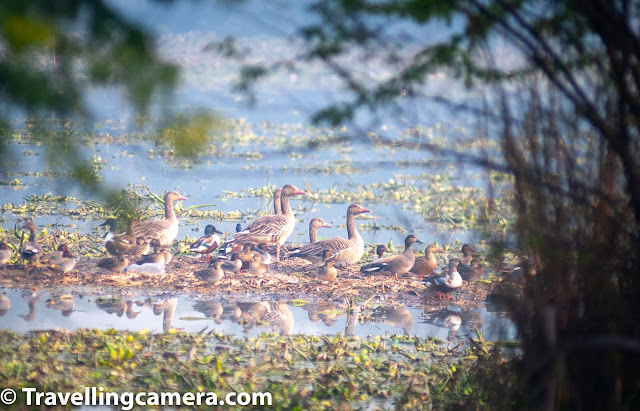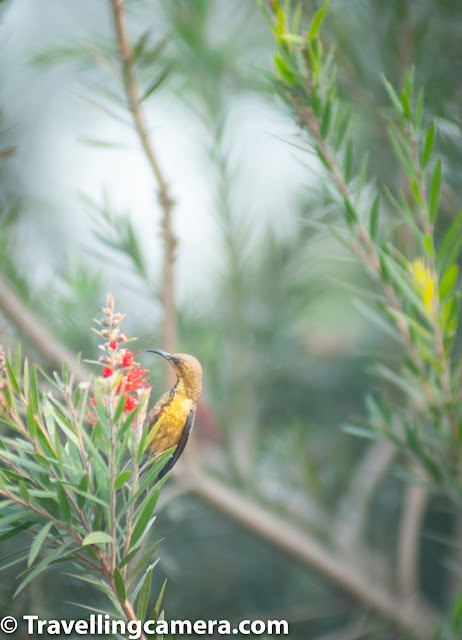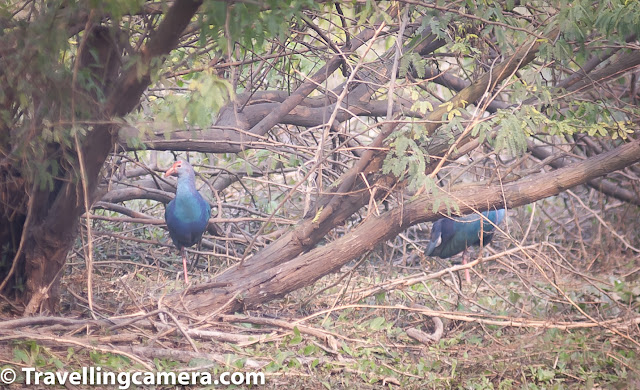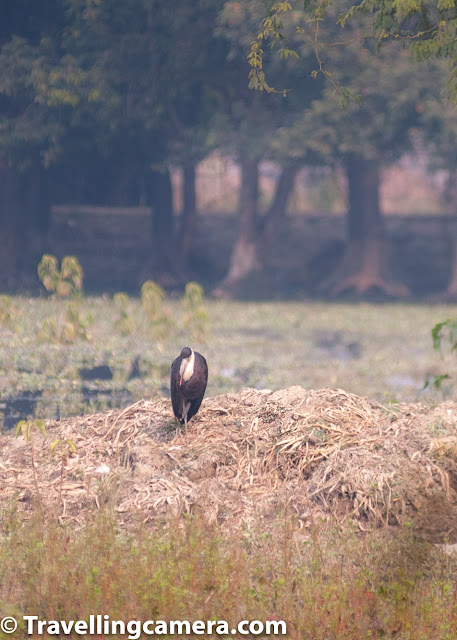 |
| Greylag Geese with Northern Shovelers and Grebes |
This is part 2 of the post about our visit to the Surajpur Bird Sanctuary. By the end of the last post, we had come quite deep inside the bird sanctuary, however, we were yet to spot the Greylag Geese, which our birder friend had confirmed he had spotted two weeks back. So far we had come across stilts, ruffs, warblers, and wagtails. Click here to read part 1 of the post.
 |
| Long-tailed Shrike |
Long-tailed Shrike is found in South and Southeast Asia. The long-tailed shrike is also known as the Butcher Bird because it is known to impale its prey on grass twigs. The bird feeds on flying insects, catches fish from rivers, snakes, and at times also feeds on fruit. It has been observed trying to impale neem fruits in Kerala. It's plumage is remarkable, with rufus underparts, rufus to brownish wings and a black mask on the eyes. Another interesting aspect of this bird is its ability to mimic various sounds - such as the calls of cuckoo and lapwings, and the sound of puppies and squirrels.
 |
| White-throated Kingfisher |
One bird we would like to acknowledge for its patience and generosity was the White-throated Kingfisher. This particular Kingfisher sat in deep meditation on this tree stump, very close to the shore of the wetland. It gave VJ enough time to click some good pictures. Of course this patience would definitely mean trouble later for some poor fish underwater. We weren't able to witness the hunt though.
 |
| White-throated Kingfisher |
The White-throated Kingfisher not only feeds on fish, it also eats insects, small reptiles, frogs, rodents, crabs, and even small birds such as Indian White-eye, Sparrows, or Munias. That is why it is often found perched on powerlines in areas that are far away from any wetlands. The White-throated Kingfisher is the most commonly spotted Kingfisher in this belt.
 |
| Greylag Geese with Northern Shovelers and Grebes |
We moved ahead and were suddenly alarmed by loud flapping of wings. And then we caught sight of two grey-legged geese fleeing. They had apparently heard us approaching and these sensitive birds did not like it. So they took flight. Our birder friend was now able to spot hundreds of these geese in the distance. By now, we had covered almost half of the distance of the sanctuary. We walked ahead in the hope of clicking better pictures of these birds.
 |
| Greylag Geese with Northern Pintails and Mallards |
By now, we could hear the quacks and splashes and knew that we were close to their resting site. Apparently they had earlier gathered close to the entrance of the sanctuary but for some reason had now moved deeper. We were speculating about the reasons - may be it was the stray dogs that were irritating and threatening them, may be it was visitors. There was no way to know for sure though.
 |
| Black-necked Stork |
Just then a Black-necked Stork surprised us by flying overhead. It took a couple of circles and then settled somewhere in the trees, not to be seen again. These storks are resident across the Indian Subcontinent and Southeast Asia. They are the largest storks in this region, but tend to avoid too much publicity. Their black head has purple or green iridescence. Like other storks, they are waders and feed on aquatic organisms.
 |
| Greylag Geese |
And finally we chanced upon them - the Greylag Geese. And sure enough there were hundreds of these large beautiful birds. Greylag geese are winter visitors to India. They have bluish-grey plumage with dark spots and stripes on belly and upper parts. And their legs and bill are pink. Grelag Geese often mate for life and the colonies are known to have both heterosexual as well as homosexual pairs, and both types of pairs have been observed to indulge in courtship and sexual activity.
 |
| Marsh Sandpiper |
In the meantime, smaller waders were keeping us constant company. Now we came across the Marsh Sandpiper, which was busy foraging for food on a rock and in surrounding hyacinth. The Marsh Sandpiper feeds mostly on insects and other such small prey. It is a rather small shank with greyish brown upperparts and light belly. It has pointed dark bill and long greenish legs. It is a winter visitor in India, and is found mostly in landlocked lowlands and avoids coastal areas.
 |
| Spotted Owlet |
We had almost completed our round of the sanctuary, when our birder friend spotted a Spotted Owlet perched on a tree stump in broad daylight. The little owl was observing us calmly. It's head turning to track our movements. Bet it owls or owlets, they always come across as wise creatures, I don't know why "ullu" is supposed to be derogatory in Hindi. These are cute and wise creatures.
 |
| Spotted Owlet |
The spotted Owlet is a short and stocky bird with greyish-brown upperparts with white spots. It's yellow keen eyes were visible through the binoculars. The Spotted Owlet roosts during the in parties of 3-4 owls in tree cavities, leaves, or branches. They are mostly nocturnal but can sometimes be spotted during the day. They are found in farmlands and close to human settlements because of abundance of prey such as small rodents there.
 |
| Neelgai (Female and babies) |
Just when we had started thinking that our trip was coming to an end, we chanced upon a Neelgai family. They were standing still outside the electrified fence, watching us keenly. We stopped in our tracks and just knew that even a slight movement from us, would then send them into a frenzy. However, ultimately, it wasn't us who caused the frenzy. Some Neelgais inside the park decided to take flight. They rushed through the water, crossed the track in an alarm and without giving any heed to the so-called electrified fence, broke out of the park. It was then that we realized the reason behind the breach in fences we had observed at several places. Truth is, you may want to restrain life, but it will break free. It made me strangely happy.
 |
| Brown Rock Chat |
The Brown Rock Chat or Indian Chat is very similar to the Indian Robin in appearance, but is larger. It has brown upperparts and rufus-brown belly. It feeds on insects captured mostly on the ground. We spotted this bird during the last leg of our tour of the sanctuary. It was perched at a distance in the middle of the lake on a tree stump. It did not seem in a hurry to get anywhere, so VJ was able to get a good shot despite the difference.
 |
| Purple Sunbird (Female) |
Purple Sunbird is often seen flitting around in flowering trees, bushes, and vines, and some people mistake them for hummingbirds. The truth is that there hummingbirds are very different birds and aren't found on this side of the world. Anyway, moving on to the sunbirds, the one in the above photograph doesn't look too purple. The reason is that it is a male in its non-breeding plumage. It is the breeding male that is purple. Another interesting aspect of sunbirds is that we have always found some on or close to bottlebrush trees. We established this connection first in Himachal, where a bottlebrush tree in our yard is a regular haunt of a crimson sunbird. The purple sunbird we saw in Surajpur was also flitting on a bottlebrush tree.
 |
| Grey-headed Swamphen |
Strangely, we saw several interesting birds right before we exit the sanctuary. This pair was hiding in the bushes on the shore of the lake. Grey-headed Swamphen is a type of Rail and was earlier considered to be a subspecies of the Purple Swamphen. It was elevated to a full species status in 2015.
 |
| Grey-headed Swamphen |
The swamphen is a strong flier as well as swimmer and is quite eye-catching with its blackish blue plumage and an orange crown. So if a swamphen is around and you are observant, chances are that you will not have to work too hard to locate it. Photographing it is another matter altogether.
 |
| Woolly-necked Stork |
It was towards the end of our trip that we came across our old friend, the Woolly-necked Stork. The last time we had seen it was in Bharatpur, where we had seen at a distance. The bird looked quite comfortable in its solitude and I was kind of fascinated by its black wings that looked like a tux and its thick neck that looks quite woolly from the distance. Our birder friend used the beautiful analogy of a muffler to describe its neck. Those were just the words I was looking for.
 |
| Great Egret |
Absolutely the last bird we saw during our trip was the Great Egret. The bird was quite far away, but we could recognize it because we have seen it at multiple times in the past. Other birds we saw here were the Rufus Treepie (see part 1 of this series for photograph), Pied Bushchat, Shikra, and Indian Silverbill. The last three could not be clicked though.
By now we had spent almost three hours in the sanctuary and had seen many new birds. It had been a great day. All thanks to our birder friend, Rakesh Ranjan, who not only arranged for permissions but also guided and directed us throughout our trip. It wouldn't have been possible without him.


.jpg)
Comments